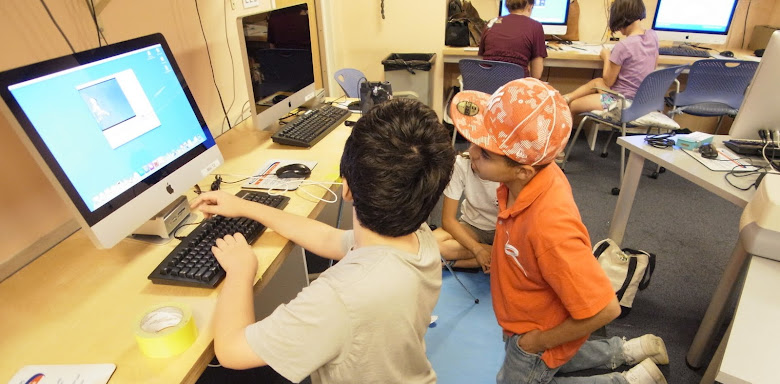I've seen SMARTboards in action and I even fought for one at my son's school a few years ago. I've seen how young learners love the immediacy and connectedness of it. In my further studies related to SB, I went to Smart Exchange (http://exchange.smarttech.com/#tab=0) and reviewed the following lesson plan called: Pop Art: What Inspires an Artist? The lesson says that it can be used for elementary through high school age students. In this Smartboard lesson, the first slide gives you a magnifying glass and asks students to consider the question--What Inspires an Artist? By guiding the magnifying glass over empty frames, what is revealed are concepts like: love, money, fame, etc. The second slide which shows a Marc Chagall, asks the viewer to consider what inspired Chagall--and I couldn't get the slide to work to show me what inspired him! Kind of frustrating. The next slide on M.C. Escher also didn't work. The next slide on religious artworks had the answer cut off a bit on the bottom part of the screen. The next few slides were not game-like and just stated, in general, what are art movements and what inspires artists in various art periods. I like slide 12 which states on the bottom--"to understand art, it helps to know what is going on when the artwork was made." Art is ultimately about history. Slide 13 asks students to create an artwork about the present day and slide 14 contains a bit of a chart to help students organize various categories of history including--politics, technology, economics, lifestyle, etc. The next few slides gives an intro to various pop artists--there is a lot of text on the slide as well as various images of the artist's works. Slide 21 has an imported crossword puzzle about pop art for review. The students can write in the answers using a SB marker. The last 4-5 slides are slides for a teacher to look at which gives some essential questions as well as a rubric.
I have to confess, that one of the things I've been doing for many years is teaching art history to students. All in all, I found this SB lesson, quite rudimentary--almost trite in its definitions of what inspires artists. The SB lesson was very glossy with all the images and then the text on the top. Why not just show a student an image of an artwork? Why does there have to be a long definition of who the artist is and what he does on the top of the slide? Could there have been a better way to organize the material? I also felt that the SB slides were kind of trivial in a way--almost like silly games to get students to critically think. I briefly looked at another SB lesson about copyright and the example used was JK Rowling and the Harry Potter books. I found that lesson also kind of silly--skipping over major facts and issues about copyright--not even mentioning fair use. And, the whole thing was being "narrated" by a purple wizard.
Prior to looking at these two lessons, I was really into SBs. I know how important they are to multi-modal learners. I know my son couldn't learn half the things he knows without having one in his classroom. I have seen how smart teachers use the SB to review course material, to show videos or to play math or reading games during school breaks or at the end of the day. So, I'm a bit saddened to see two SB lessons which I consider to be just mediocre at best. Perhaps, these new opinions are being clouded by the brilliant podcast with technology educator, Alan November (http://novemberlearning.com/) that I listened to right before looking at the SB lessons. I really enjoyed this great resource: SMARTboard Lessons Podcast at http://pdtogo.com/smart/?p=93 even though this particular one with November was from July 2007. So much of what he said still rings true for today including stating his belief that "teaching children to add value to the world and teaching children to have self-respect and empathy" are some of the most important things we need to teach students. He also noted that corporations seem to value collaboration, risk--but schools don't and that school is like "the learning police--we block the cool things--podcasts, IM, blogs, etc." I so agree with this idea! Look at NYC public schools which don't even allow students to have cell phones (most put them on silent in their coats and backpacks!) November also stated that the job of a teacher is to understand how students can use lots of technological applications and how we, as educators can demand more rigorous assignments. He doesn't think teachers have to know every bit of technology out there--let the students guide the teacher--that's called collaboration. November noted that to him, "the white board is a $2k blackboard in many classes and that it takes a really gifted teacher to work it well." He stated that he prefers technology where students each have something on their desk--a computer, an ipod, etc. He also states that faculty should be engaged and transformed in SB technology and the principal should use a SB during faculty meetings. Further, he notes that "wikis, blogging, web portals, podcasting--everything should flow together--it should be a continuum of interconnectedness." Lastly he states--technology has to be about equity--that we have to enable access to all students and that the reality is that technology is not an equalizer--it is an enormous polarizer." November gives you a lot to think about--and I agree with his analogy of a SB as a giant expensive blackboard. I do think that a SB is very helpful for K-8, but I hope that by the time a student is in high school, that s/he has his own laptop and that they are using all sorts of educational technologies to learn.

No comments:
Post a Comment